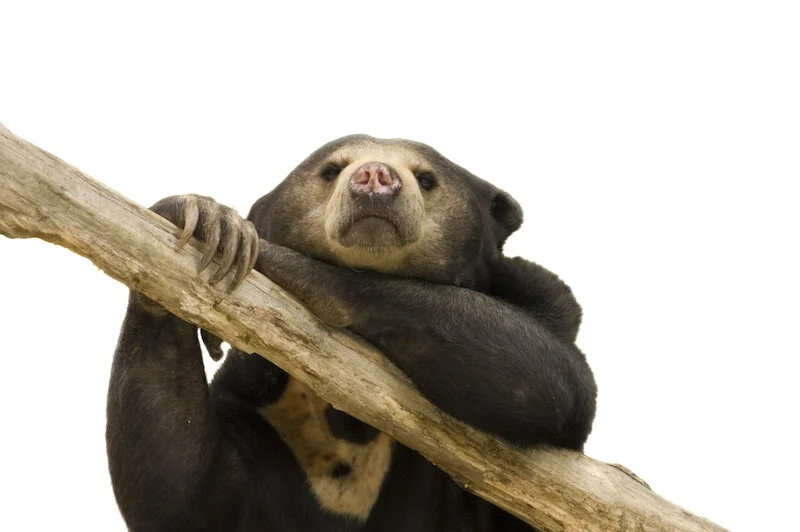Sun bears are small bears.
They live in hot rainforests.
They spend a lot of time in trees.
They eat plants and meat.
They have a yellow V mark on their chest.
Malayan sun bears spend a lot of time in trees. ©Getty Images
General facts about all bears:
Bears are mammals.
Bears are found in many habitats in different countries.
Bears all have a large body with strong legs and a short tail. They have a snout rather like a dog's snout. They have thick fur. Their paws have five claws that do not pull back like a cat's claws do.
Bears generally live alone, except when a mother is raising cubs.
There are eight different kinds of bear.
See a map of where the different kinds of bear are found
https://databayou.com/bear/habitat.html
The Malayan sun bear is the smallest of the eight species (kinds) of bear.
Some people believe it is possibly one of the fiercest of the bears. Not much is known about the Malayan sun bear because they are hard to track in their thick forest habitat.
Habitat and distribution (where they are found)
Malayan sun bears live in southeast Asia in the eastern Himalayas, China, Burma, Cambodia, Laos, Thailand, Sumatra, Borneo and Malayasia, a few places in Japan and in Taiwan.
Tropical forest habitat ©Getty Images
They live in thick tropical rainforests, in lowland areas rather than in the mountains. They are spend a lot of time in trees.
Appearance and Behaviours
Malayan sun bear in Thailand. ©Getty
The Malayan sun bear stands at about 70 cm and weighs about 30-65 kilograms. Females are a bit smaller. Nose to tail, they are a bit over one metre long. Although it has 'sun' in its name, the sun bear is nocturnal, which means it is mainly active at night. Sun bears sleep in the day in nests they make in trees. They do not hibernate like other bears, because in their habitat food is plentiful all year round and the winters are not cold.
Its solid body is covered with short, smooth fur. It has a short tail and rounded ears, and an orange-yellow V mark on its chest, which people thought resembled a rising or setting sun.
The sun bear has a very long tongue. ©Getty Images
It has a very long 25 cm tongue which is used for getting honey out of bee hives and insects out of cracks. It rips apart logs with its 10 cm long, strong claws. An excellent climber, it has no fur on the soles of its feet for better grip when climbing trees.
The Malayan sun bear's skin is very loose, so that when it is bitten by predators, it can still turn and fight. Its fur is short but thick, which protects it from scratches.
Diet
The sun bear is omnivorous, meaning it eats plants and meat. It feeds on berries, roots, fruit, small rodents, insects, lizards, birds and earthworms. It climbs trees to get honey made by wild bees. It is often called a honey bear because of this.
Sun bear finding food.©Getty
Sun bears also climb farmed coconut palms and eat the heart of the palm trees. Many of the bears are killed by farmers, who thinks they are pests.
Life Cycle
About 100 days after mating with a male, the female gives birth, normally to two cubs, in a nest in the forest undergrowth. The cubs weigh about 225 grams, and are blind, hairless and helpless. Their skin is almost transparent. However, after about 1-2 months, they are able to forage for food with their mother. The cubs stay with their mother until they are almost fully grown.
Because the bears are nocturnal and live in remote areas, not much is known about their life cycle. It is believed that sun bears live for about 24 years in the wild.
Malayan sun bear©Getty Images
Conservation Status and Threats
Young sun bear relaxing ©Getty Images
The sun bear is classified as Vulnerable. Because the bear is so shy and lives in remote places, it is not known how many still exist in the wild. However, their habitat is rapidly being destroyed.
One major threat they face is that it is believed by some people that the gall bladder and other body parts of the sun bear can be made into magical medicines. This is not scientifically true, but many still believe it and poachers hunt them.
Its a good idea to find information from more than one source!
Read more about sun bears
Watch a video to see a sun bear moving about in its habitat
https://www.youtube.com/watch?v=N1KeYup5r7s








